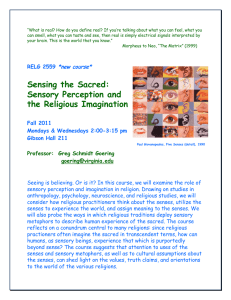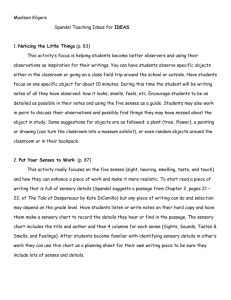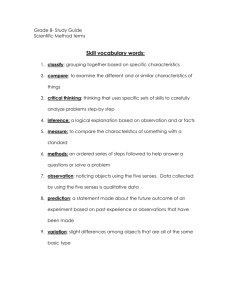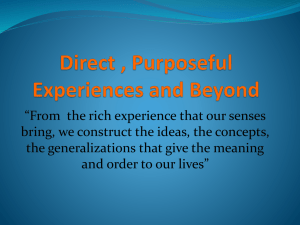21A.260 Culture, Embodiment, and the Senses Vivian Li
advertisement
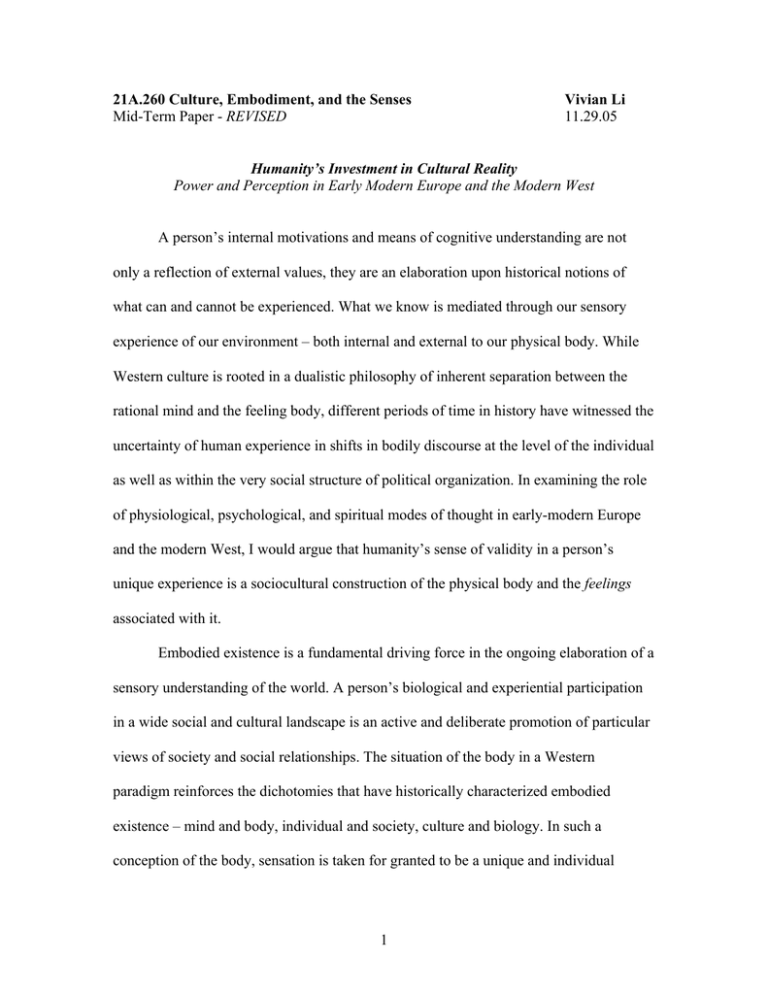
21A.260 Culture, Embodiment, and the Senses Mid-Term Paper - REVISED Vivian Li 11.29.05 Humanity’s Investment in Cultural Reality Power and Perception in Early Modern Europe and the Modern West A person’s internal motivations and means of cognitive understanding are not only a reflection of external values, they are an elaboration upon historical notions of what can and cannot be experienced. What we know is mediated through our sensory experience of our environment – both internal and external to our physical body. While Western culture is rooted in a dualistic philosophy of inherent separation between the rational mind and the feeling body, different periods of time in history have witnessed the uncertainty of human experience in shifts in bodily discourse at the level of the individual as well as within the very social structure of political organization. In examining the role of physiological, psychological, and spiritual modes of thought in early-modern Europe and the modern West, I would argue that humanity’s sense of validity in a person’s unique experience is a sociocultural construction of the physical body and the feelings associated with it. Embodied existence is a fundamental driving force in the ongoing elaboration of a sensory understanding of the world. A person’s biological and experiential participation in a wide social and cultural landscape is an active and deliberate promotion of particular views of society and social relationships. The situation of the body in a Western paradigm reinforces the dichotomies that have historically characterized embodied existence – mind and body, individual and society, culture and biology. In such a conception of the body, sensation is taken for granted to be a unique and individual 1 experience of some concrete external object in an assumed separation of the body and the natural world. Through a passive and active engagement of the world, the senses themselves are modified by experience, and a history of what is “real” is somatically internalized to reflect the body’s unique relationship to conceptual reality. Since it is the senses which ultimately mediate how these external realities are interpreted, the very power structure of society is tied to the differential allocation of morally permissible sensory experience – because perception both shapes and defines social reality. The way in which knowledge about objects we perceive is obtained and processed is an internalized understanding of what is and is not a culturally defined form of truth. From symbols to familiar faces, the visceral experience of recognition and interpretation is based upon assumptions of significance that cannot be explained without appealing to a cultural model of interpretation. In a way, culture tunes a person’s attention to particular modes of knowledge and assigns value to things, forming a sort of economy of sensory encounter. By giving certain bodily senses more or less implicit priority in the normal activity of everyday life, the body itself is conceived as regulated with respect to the external. The body, therefore, is an agent of communication that perpetuates acceptable behaviors and is both transformed by external influence and also a transforming authority itself. Within early modern Europe, a predominant anxiety dealt with defining the Cartesian split between a superior mind and the body’s “animal spirits” (Descartes 1985: 139, Palmer 1993: 62-64, Bylebyl 1993: 55). This dualism reflected the societal value placed upon rationality versus the affective sway contained in the body’s senses. As Scott Manning Stevens posits for the role of the “naked savage” in Western thought at this time, 2 the body was a “mnemonic of our shared human condition by which we are reminded of our common needs, our common desires, and our common vulnerability” (Stevens 2003: 126). Personal power and control meant maintaining a regulated sensorium and exhibiting bodily customs that separated “cultured” from “savage.” Prevailing moral values of religion informed most of the emerging understanding of the European “encounter” with the bizarre conventions of the native body. The category of “the Other” was generated by means of the body and senses as characteristic features extending beyond appearances and further used to perpetuate policies of international relations and racial segregation. Judeo-Christian interpretations of bodily differences include the early European notions of Blackness as a sign of “divine disfavor, a token of God’s judgment on Cham and his descendants” (Stevens: 128-129). Their perceived inferiority coupled with a physical - and correspondingly, cultural – nakedness justified their position of slaves by nature. This manner of thought generated a political philosophy of moralizing and fetishizing the Other in that they were “essentially different from the European breed; and it was this mode of relationship that underlay the policies of war and extermination which the Europeans followed throughout the seventeenth and most of the eighteenth century” (ibid.: 127-128). Similarly, the different modes of sensing attributed to a man and woman became justification and reinforcement for a division of power and social circumstance (Keller 2003, Classen 2005). The experience and practice of touch has been particularly powerful in crafting socially and politically distinct groups. Historically and cross-culturally, touch has differed from the other senses in that it is not localized in a particular organ or position of the body, yet it governs much of how bodies conceive of both tangible and intangible 3 experience (such as the notion of feeling without a physical encounter). In the political domain, however, the Western preference for visual metaphors and tropes over those based on aural and tactile experience was examined by Walter Ong as a move towards idealism and abstraction from the concreteness and subjectivity of touch (Stevens 2003: 125). Indeed, the cultural distance placed between civilized man (removed from nature) and native (exposed within nature) is replicated in the transformation of an entire body’s naked vulnerability into a controlled practice of touch, which has ultimately been situated in the deliberate action of the hand. It is no small consideration that the progress of civilization itself is based on whether a society has developed the use of clothing, tools, or customs that distance sensual skin from its environment. Within contemporary society, the practice of touch promotes a social hierarchy based on profession and skill, something especially apparent in the scientific and medical field which has sought to regulate and stylize the ways of touching by limiting even what is culturally acceptable to touch. The concentration of sensory power in an organ which holds so much cultural significance demonstrates a cultural urge to compartmentalize and regulate that sense of touch – sometimes disposing of it entirely. Furthermore, the medicalization of touch reveals a gendered and inherently moral division of autonomy and power that reflects the historical dominion of a physician whose work was “more dignified, being the work primarily of the head not the hand” (Porter 1993: 185). Medical developments in the seventeenth and eighteenth century gave unexpected utility to the historically undignified practice of manual therapy, notably in the field of midwifery. The rise of man-midwives against social condemnation speaks to the powerful role of touch emerging in Western medicine as well as the simultaneous need to normalize, stylize and rationalize anything 4 that falls outside of acceptable customs (Keller 2003: 75, Porter 1993: 196). Touch – once the domain of the feminine, unenlightened practitioner – became a surprisingly valuable way of knowing, manipulating, and healing the body. However, to be practiced in accordance with social expectations of medical authority, the methodology of touch had to be reconceptualized as “masculine attributes of reason and decorous action…a refashioned image of the midwife emerges: one who is self-sufficient, possessed of native authority, and powerfully effective in the world of action by a unique ability to merge mind and body, knowledge and practice” (Keller 2003: 70-71). In this way, touch is stylized to adhere to a cultural standard of medical efficacy, and the entire methodology of healing is recreated in agreement with cultural ideas of gender and medical practice. Constance Classen, in her analysis of how witchcraft usurped masculine authority in sensory domains, provides further claims for the general movement of medicine at this time away from the domestic (feminine, quack) realm and towards the “development of sight-based practices and technologies, such as anatomical dissection, clinical observation and microscopic analysis…suitable only for men” (ibid.: 80). With the development of “modern” modes of study in the West, the body’s role as either an agent, a foil, or even a proprioceptive extension of the mind is no closer to being resolved. However, the ways in which society has come to deal with this perceived duality is still inextricably tied to history as well as political instability. When the reality of psychological trauma (those with concrete external roots) came to the wide-spread attention of the medical community following WWI, there was already a long-standing belief (religious, psychoanalytical, suggestive or otherwise) in the inseparable nature of the mind and body in sickness and healing (Freud, Kaptchuk 1998: 390-393, Leys 1996: 5 103-105). The proliferation of disease categories, analytical frameworks, and religious philosophy in the area of mind-body epistemology speaks to a need to make positive social predictions of how the body as a thinking, sensing being is amenable to the wider cultural schema in what Nancy Scheper-Hughes and Margaret Lock would call the “body politic” (1987:25). The cultural tools that enable a person to make sense of their experience shape the way that they think, behave, and communicate. One way of thinking about how society encourages (or demands) a particular way of interpreting experiences is contained within the practice of modern Western medical research. The method of blind assessment has a long history of use for separating the “palpable real” from the “immaterial fake.” In doing so, it has not only proven the social reality of subjective experience and the power of suggestion, it has also simultaneously created a set of standards upon which people base questions of truth. Instead of the validation or search for truth, science is, in fact, guided by social forces towards fabricating the basis for what constitutes valid and acceptable knowledge. It is only too clear how this approach towards understanding is a “struggle for moral authority, persuasive rhetoric, and the power that legitimacy confers” (Kaptchuk 1996:393). People are held in check by their very ability to rationalize their senses and interpret their experiences. These ideas about what is objective truth and what is subjective experience map onto our understanding of the body and mind, extending even to domains of emotional or spiritual experience that question the role of autonomous selves in relation to the power of cultural authority. Modern society still retains ambivalence towards the role of an autonomous self in relation to how bodies sense their surroundings, communicate with others, and the 6 extent to which they are influenced by the wider political construct of Western society. The dichotomy of self and society is based in an ongoing tension between what Freud would view as a return to the idea of internal or unconscious desires in conflict with the external social and moral order (Freud: 143-145). Thus, there is a private and a public concept of the self that further divides our understanding of acceptable (reasonable) behavior, even in the experience of mental malady or physical distress. For example, in victims of traumatic bodily memory (a external trauma that is imprinted within conscious memory), “individuals ‘choose’ PTSD…to reorganize their life-worlds, because it is a widely known and ready-made construct sanctioned by the highest medical authorities and said to originate in external circumstances rather than personal flaws or weaknesses” (Young 1996:98). The intrusion of external events on a person’s world-view speaks to the potential for political control of a social body not just in sickness, but also within the everyday experience of communication. How people interpret their own internal states is definitely a part of the dynamics of interaction between people and cultures. Thus, how we understand each other through body language, empathy, violence, and physical affection are reflections of the interpretations with which our culture has equipped us. In the modern West, these arsenals of expression are contained within religion, medicine, science, law, and other social organizations with profound control over individual minds and bodies. The medical and therapeutic roles of culture in modern life have experienced a shift towards an increasingly centralized and politically controlled framework. ScheperHughes and Lock state that “radical changes in the organization of social and public life in advanced industrial societies, including the disappearance of traditional cultural idioms 7 for the expression of individual and collective discontent (such as witchcraft, sorcery, rituals of reversal and travesty), have allowed medicine and psychiatry to assume a hegemonic role in shaping and responding to human distress” (1987:26-27). The influence of cultural politics on a person’s emotional reaction to feelings of sickness and suffering show how entrenched we are in certain modes of expression and speak to the reality of a body’s ability to physically manifest symptoms of societal distress. However, those symbols of distress change as a society continues to regulate the dynamic interactions and experiences of individuals within a culture. This is accomplished through a deliberate move towards particular forms of knowledge production and validation that advance the culture and its goals as a whole. In many ways, however, the discourse of the senses remains relatively unchanged from its historical precedents. Although there is a recognition of the importance of embodied experience, people in the West are still enclosed in a sensory landscape that values the visual and the aural above all others. The role of technology creates a population who are effectively disembodied from each other on many levels of communication (cellular phones, internet, television, etc.) while the increasing commoditization of bodies themselves abstract a visual representation from the physical reality of an individual. Fashion and self-help magazines mold perceptions of what constitutes socially desirable health (emotional and physical) while others like National Geographic depict (and reinforce) a generalized representation of the modern Other, wholly different and separated from ourselves. The role of touch, as explored earlier within early European ideals, has become even more of a carefully regulated experience in the domain of medicine and therapeutic healing, social rituals such as hand-shaking, 8 and other aspects of a “look, don’t touch” culture. Within this culture, the production of socially appropriate and subordinate bodies is still relayed through the senses – whether it is as media images of an aesthetically desirable figure, the use of sensory deprivation in military torture, or other derivations of the body politic (Scheper-Hughes and Lock 1987: 24-27). The body throughout history has taken a very active role in the development of a society and its philosophy of power in the same way that the culture has shaped the very interpretation of experience. The individual body’s sensory encounter is defined through a physical and interpretive perception of the objects, ideas, and goals surrounding it. This separation between the internal and the external reality is mediated through the senses, which are in turn defined by the conceptual models that a culture provides. A person’s singular experience (emotional and physical) is therefore a shared investment in a society’s system of truth, and it is this interplay of cultural and political values which build a hierarchy of power in the anthropology of the senses. 9 Bibliography Jerome Bylebyl, “The Manifest and the Hidden in the Renaissance Clinic,” in Medicine and the Five Senses, (1993) pp. 40-60. Constance Classen, “The Witch’s Senses: Sensory Ideologies and Transgressive Femininities from the Renaissance to Modernity,” in Empire of the Senses: The Sensual Culture Reader, (2005) pp. 70-84. Descartes, “Discourse on the Method,” in The Philosophical Writings of Descartes, (1985) Vol.1, pp. 111-151. Sigmund Freud, “The Uncanny,” pp. 123-162. Ted. J, Kaptchuk, “Intentional Ignorance: A History of Blind Assessment and Placebo Controls in Medicine,” Bull. Hist. Med., 1998, 72: 389-433. Eve Keller, “The Subject of Touch: Medical Authority in Early Modern Midwifery,” in Sensible Flesh: On Touch in Early Modern Culture, (2003) pp. 62-80. Ruth Leys, “Traumatic Cures: Shell Shock, Janet, and the Question of Memory,” in Tense Past: Cultural Essays in Trauma and Memory, (1996) pp. 103-145. Richard Palmer, “In Bad Odour: Smell and Its Significance in Medicine from Antiquity to the Seventeenth Century,” in Medicine and the Five Senses, (1993) pp. 61-68. Roy Porter, “The Rise of Physical Examination,” in Medicine and the Five Senses, (1993) pp.179-197. Nancy Scheper-Hughes and Margaret Lock, “The Mindful Body: A Prolegomenon to Future Work in Medical Anthropology,” Medical Anthropology Quarterly, New Series, Vol. 1, no. 1 (March 1987): 6-41. 10 Scott Manning Stevens, “New World Contacts and the Trope of the ‘Naked Savage,” in Sensible Flesh: On Touch in Early Modern Culture, (2003) pp. 124-140. Allan Young, “Bodily Memory and Traumatic Memory,” in Tense Past: Cultural Essays in Trauma and Memory, (1996) pp. 89-102. 11


